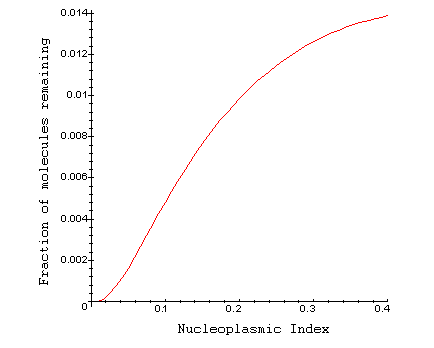
NUCLEO-CYTOPLASMIC TRANSPORT
Introduction: The membrane of the nucleus is perforated by nuclear pores that permit the entry of water soluble molecules from the cytoplasm into the nucleoplasm. Small molecules in the cell cytoplasm needed for processes in the nucleus typically penetrate through the nuclear envelope by diffusion.
Importance: The rate at which molecules enter the nucleus depends on the volume and surface area of the nucleus, as well as the volume of the surrounding cytoplasm. We can use simple equations to describe how these cell properties affect the rate of nucleo-cytoplasmic transport.
Question: How is the rate of diffusion of molecules into the nucleus affected by properties of the cell?
Variables:
|
N |
number of molecules in cytoplasm |
|
N0 |
initial number of molecules in cytoplasm |
|
K |
rate of diffusion of molecules into nucleus (1/sec) |
|
t |
time (seconds) |
|
p |
constant depending on the properties of the diffusing molecules (micrometers/sec) |
|
S |
surface area of the nucleus (micrometer2) |
|
Vn |
volume of the nucleus (micrometer3) |
|
Vc |
volume of the cytoplasm (micrometer3) |
Method: The fraction of molecules remaining in the cytoplasm, N/N0, can be considered to decay exponentially over time at a rate K:

The rate of influx (K) depends on the nuclear surface area (S) and volume (Vn) as well as the volume of the cytoplasm (Vc) and can be expressed as

where p is a constant depending on the size, permeability, and concentration of diffusing molecules. At a particular point in time, we can compare cells with large nucleoplasmic ratios (large nucleoplasmic volume relative to cytoplasmic volume) to cells with relatively small nuclei. Let's graph N/N0 as a function of Vn assuming Vc = 1, p and t are constants. Since Vc = 1, we can consider the x-axis the nucleoplasmic index, Vn/Vc. S, the surface area of a spherical nucleus, is written in terms of the nuclear volume, Vn (see Additional Questions).

Interpretation: For large cells with a small nucleoplasmic ratio (small nuclear volume relative to cytoplasmic volume), molecules penetrate easily into the nucleus. The fraction of molecules remaining in the cytoplasm at a particular point in time is quite low. For cells with a large nucleus, however, the rate of diffusion of molecules into the nucleus from the cytoplasm is reduced and a larger fraction of molecules remain in the cytoplasm.
Additional Questions:
1. The surface area of a spherical nucleus is given by S = 4pr2 and the nuclear volume is given by Vn = 6pr3, where r is the radius of the nucleus. Solve for S in terms of Vn.
2. How can the equation N/N0 be simplified if the cell volume is extremely large, that is as Vc goes to infinity?
Source: Lang, I., M. Scholz, and R. Peters. 1986. Molecular mobility and nucleocytoplasmic flux in hepatoma cells. Journal of Cell Biology 102:1183-1190
Copyright 1999 M. Beals, L. Gross, S. Harrell